 M15 (Updated Dec. 1, 2024)
M15 (Updated Dec. 1, 2024)
 M15 (Updated Dec. 1, 2024)
M15 (Updated Dec. 1, 2024)
Showcasing: M15
|
|
Designation: M15 Alternate Name: NGC7078 Constellation: Pegasus Imaging Date: December 1, 2024 Imaging Location: Concord Exposure Time: 76 frames@180sec ~ 3.8hrs Gain Setting: 100 Imaging Device: ZWO ASI2600 Optics: Classic LX200 12" SCT Focal Reducer: Meade Series 4000 f/6.3 Filter: none Apparent Size: 12.3' Comment: This is an update to my image of M15 over 10 years ago! I have to say, there seems to be something lacking in my new version that my old one seemed to evoke...it's as if the older one has a 3D look that the new one just doesn't capture. M15 is about 33,600 light-years distant, and fairly large at 175 light years diameter. M15 is also one of the densest globular clusters known, believed to be in a state of core collapse. In fact, the closer Hubble looks into its center, the more stars are visible, with its density continuing to increase to within 0.06 light years of the core! It is still unclear if the central core of M15 is packed so dense simply because of the mutual gravitational interaction of the stars it is made of, or if it houses a dense, supermassive black hole. M15 also contains 1 of only 4 known planetary nebulae in Milky Way globular clusters. |
M92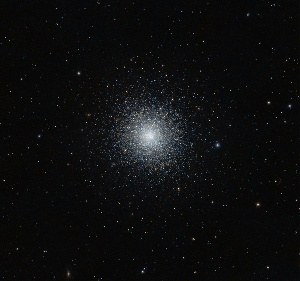
|
M13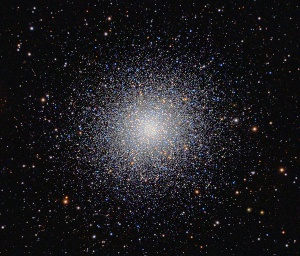
|
M5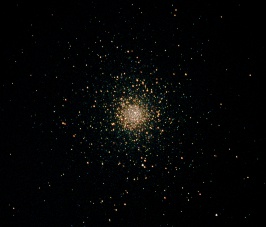
|
|
Designation: M92 Alternate Name: NGC6341 Constellation: Hercules Imaging Date: July 21, 2023 Imaging Location: Concord Exposure Time: 47 frames@180sec ~ 2.3hrs Gain Setting: 100 Imaging Device: ZWO ASI2600 Optics: Classic LX200 12" SCT Focal Reducer: Meade Series 4000 f/6.3 Filter: none Apparent Size: 12.2' Comment: A beautiful globular cluster in Hercules, often overshadowed by its larger upstart M13. A nice improvement over my 10" version from my pre-GEM mount days, using almost 10 times the exposure time. It is an example of an Oosterhoff type II globular cluster, which means it belongs to the group of metal poor clusters. It is about 110 light years in diameter and approximately 26700 light years distant. |
Designation: M13 Alternate Name: NGC6205 Constellation: Hercules Imaging Date: May 1, 2022 Imaging Location: Concord Exposure Time: 113 frames@180sec ~ 5.7hrs Gain Setting: 200 Imaging Device: ZWO ASI2600 Optics: Classic LX200 12" SCT Focal Reducer: Meade Series 4000 f/6.3 Filter: none Apparent Size: 23.2' Comment: M13 is about 145 light years in diameter and over 25,000 light years distant. Finally, an updated-updated version of this beautiful globular, this time with my ASI2600mc and over 5h of exposure time! I perfectly registered my older version with this newer one so if you can set up your browswer to switch back and forth between this one and my 26min T3I version, the difference is staggering! Interestingly, the very distinctive "tendrils" I saw in my earliest processed version here are gone! Of course, this earliest version is probably closest to what you actually see with your eye. I can't forget the first time seeing M13 with my 8inch Newtonian in a Bortle 2 sky - 40 years later, that crystal clear view is still fresh in my mind! |
Designation: M5 Alternate Name: NGC5904 Constellation: Serpens Imaging Date: July 11, 2013 Imaging Location: Concord Exposure Time: 78 frames@20sec ~ 26.0min Gain Setting: ISO 1600 Imaging Device: Canon Rebel T3i Optics: LX200R 10" SCT Focal Reducer: Optec Lepus 0.62X Filter: none Apparent Size: 19.9' Comment: I managed to get superb focus for this globular. This one is actually somewhat elliptical and quite large (approx. 165 light years in diameter), consisting of over half a million stars. It is approximately 24,500 light years away and is known for its unusually large number of RR Lyrae variable stars. |
M2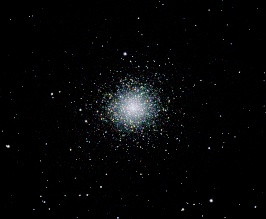
|
NGC6356
|
M19
|
|
Designation: M2 Alternate Name: NGC7089 Constellation: Aquarius Imaging Date: September 6, 2013 Imaging Location: Concord Exposure Time: 80 frames@20sec ~ 26.7min Gain Setting: ISO 1600 Imaging Device: Canon Rebel T3i Optics: LX200R 10" SCT Focal Reducer: Optec Lepus 0.62X Filter: none Apparent Size: 11.7' Comment: This is a reprocessed version of my original image here which previously had a little too much purple/blue! M2 is over 175 light years in diameter, making it one of the largest globular clusters known. It is approximately 37500 light years away and also about 13 billion years old, almost as old as the Universe itself! |
Designation: NGC6356 Alternate Name: NA Constellation: Ophiuchus Imaging Date: June 24, 2015 Imaging Location: Concord Exposure Time: 70 frames@20sec ~ 23.3min Gain Setting: ISO 1600 Imaging Device: Canon Rebel T3i Optics: LX200R 10" SCT Focal Reducer: Optec Lepus 0.62X Filter: none Apparent Size: 3.5' Comment: This metal rich globular is only about 40 light years in diameter, with a tight 1.5' core. It is located about 15000 light years away and 8000 light years from the center of the galaxy, well out of the central galactic plane. Hard to believe Herschel missed this one! |
Designation: M19 Alternate Name: NGC6273 Constellation: Ophiuchus Imaging Date: July 16, 2015 Imaging Location: Concord Exposure Time: 47 frames@20sec ~ 15.7min Gain Setting: ISO 1600 Imaging Device: Canon Rebel T3i Optics: LX200R 10" SCT Focal Reducer: Optec Lepus 0.62X Filter: none Apparent Size: 5.3' Comment: The oblate shape of this globular is definitely noticeable, but infrared images have shown that this is due to interstellar dust clouds to either side of it, blocking the view of some of its stars. The cluster is about 27,500 light years away and about 110 light years in diameter, however, closer than most to the galactic center, with a distance of about 6500 light years |
M56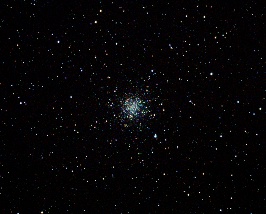
|
M3
|
M68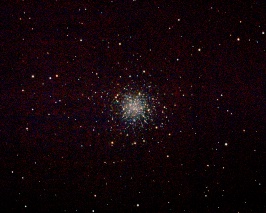
|
|
Designation: M56 Alternate Name: NGC6779 Constellation: Lyra Imaging Date: August 17, 2014 Imaging Location: Concord Exposure Time: 78 frames@20sec ~ 26.0min Gain Setting: ISO 1600 Imaging Device: Canon Rebel T3i Optics: LX200R 10" SCT Focal Reducer: Optec Lepus 0.62X Filter: none Apparent Size: 5' Comment: Magnitude 8.3 globular in Lyra follows a retrograde motion around our galaxy. It is thought to be a possible remnant from a past merger between our galaxy and a dwarf galaxy whose nucleus remained as the globular Omega Centauri! At a distance of about 32,900 light years, it's somewhat smaller than average at about 85 light years in diameter. |
Designation: M3 Alternate Name: NGC5272 Constellation: Canes Venatici Imaging Date: March 9, 2021 Imaging Location: Concord Exposure Time: 54 frames@180sec ~ 2.7hrs Gain Setting: 100 Imaging Device: ZWO ASI2600 Optics: Classic LX200 12" SCT Focal Reducer: Meade Series 4000 f/6.3 Filter: none Apparent Size: 18.6' Comment: 8 years later, with a larger scope, cooled camera and improved processing skills and this is what you get! Compare with my previous version. Messier 3 is a prototype of a Oosterhoff type I cluster, known as a "metal-rich" globular cluster. It also contains the largest number of variable stars out all the Milky Way globulars. It has a diameter of about 180 light years, and is about 33900 light years distant. |
Designation: M68 Alternate Name: NGC4590 Constellation: Hydra Imaging Date: February 20, 2017 Imaging Location: MadisonCT Exposure Time: 72 frames@20sec ~ 24.0min Gain Setting: ISO 1600 Imaging Device: Canon Rebel T3i Optics: LX200R 10" SCT Focal Reducer: Optec Lepus 0.62X Filter: none Apparent Size: 11' Comment: At about 33,000 light years from Earth, this 105 light year diameter globular is one of the most metal poor globulars in our galaxy - so abnormally metal poor in fact (containing less than 1% of the heavy metals our Sun has) that it is has been suggested our galaxy captured this globular from another galaxy we absorbed eons ago. M68 has recently been used to revise globular cluster age estimation techniques, resulting in lower estimates that are more consistent with the most current age estimates of the Universe. |
|
Go toTop of Page |
Last Updated: Dec. 4, 2024 |
Back to Home Page. |